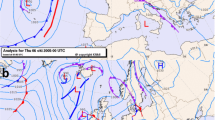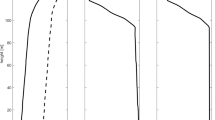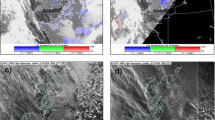Abstract
Despite the long interest in understanding fog processes and improving fog parametrization, numerical modelling of fog remains an important challenge in short-term forecasts, due to the diversity and scales of the mechanisms involved with fog parametrization. In this study, we focus on the key processes that govern performance in fog modelling in very stable conditions. Large-eddy simulations at very high resolution are tested against the observations from Cardington, UK, presented in Part I of this study. The radiation fog forms in statically stable conditions. Five hours after its formation, the fog deepens rapidly and a significant cooling associated with the formation of positive curvature can be seen in the vertical profiles of potential temperature around 50 m. After roughly 8 h of development, a mixed layer has formed at the base of the fog, driven by surface instability. We show that the model captures well the change in static stability, but fails at capturing correctly the mechanisms associated with the deepening of the fog layer. Different possible mechanisms are discussed and tested with the model, such as additional drainage flow and cold air advection, which might result from local heterogeneity. The sensitivity of these results to different microphysical parametrizations is also briefly addressed.
Similar content being viewed by others
References
Andre JC, Mahrt L (1982) The nocturnal surface inversion and influence of clear-air radiative cooling. J Atmos Sci 39: 864–878
Baas P, de Roode SR, Lenderink G (2007) The scaling behaviour of a turbulent kinetic energy closure model for stably stratified conditions. Boundary-Layer Meteorol 127: 17–36
Beare RJ, Macvean MK (2004) Resolution sensitivity and scaling of large-eddy simulations of the stable boundary layer. Boundary-Layer Meteorol 112: 257–281
Beare RJ, Edwards JM, Lapworth AJ (2006a) Simulation of the observed evening transition and nocturnal boundary layers: large-eddy simulation. Q J R Meteorol Soc 132: 81–99
Beare RJ, Macvean MK, Holtslag AAM, Cuxart J, Esau I, Golaz J-C, Jimenez MA, Khairoutdinov M, Kosovic B, Lewellen D, Lund TS, Lundquist JK, Mccabe A, Moene AF, Noh Y, Raasch S, Sullivan P (2006b) An intercomparison of large-eddy simulations of the stable boundary layer. Boundary-Layer Meteorol 118: 247–272
Bergot T, Guedalia D (1994) Numerical forecasting of radiation fog. Part I: Numerical model and sensitivity tests. Mon Weather Rev 122: 1218–1230
Bergot T, Carrer D, Noilhan J, Bougeault P (2005) Improved site-specific numerical prediction of fog and low clouds: a feasibility study. Weather Forecast 20: 627–646
Bott A, Sievers U, Zdunkowski W (1990) A radiation fog model with a detailed treatment of the interaction between radiative transfer and fog microphysics. J Atmos Sci 47: 2153–2166
Brown AR, Derbyshire SH, Mason PJ (1994) Large-eddy simulation of stable atmospheric boundary layers with a revised stochastic subgrid model. Q J R Meteorol Soc 120: 1485–1512
Brown AR, MacVean MK, Mason PJ (2000) The effects of numerical dissipation in large eddy simulations. J Atmos Sci 57: 3337–3348
Clark PA, Hopwood WP (2001) One-dimensional site-specific forecasting of radiation fog. Part I: Model formulation and idealised sensitivity studies. Meteorol Appl 8: 279–286
Cox PM, Betts RA, Bunton CB, Essery RLH, Rowntree PR, Smith J (1999) The impact of new land surface physics on the GCM simulation of climate and climate sensitivity. Clim Dyn 15: 183–203
Deardoff JW (1978) Efficient prediction of ground surface temperature and moisture, with inclusion of a layer of vegetation. J Geophys Res 83: 1889–1904
Duynkerke PG (1999) Turbulence, radiation and fog in Dutch stable boundary layers. Boundary-Layer Meteorol 90: 447–477
Edwards JM (2009) Radiative processes in the stable boundary layer. Part II: The development of the nocturnal boundary layer. Boundary-Layer Meteorol 131(2): 127–146
Edwards JM, Slingo A (1996) Studies with a flexible new radiation code. Part A: Choosing a configuration for a large-scale model. Q J R Meteorol Soc 122: 689–719
Edwards JM, Beare RJ, Lapworth AJ (2006) Simulation of the observed evening transition and nocturnal boundary layers: single-column modelling. Q J R Meteorol Soc 132: 61–80
Esau I (2009a) Large-eddy simulation experiments with nudging to observed mean meteorological profiles. Geophys Res Abstr 11:EGU2009-1496
Esau I (2009b) Numerical experiments with assimilation of the mean and unresolved meteorological conditions into large-eddy simulation model. arXiv.1002.1632
Fuzzi S et al (1992) The Po valley fog experiment 1989—an overview. Tellus 44: 448–468
Gultepe I, Milbrandt JA (2007) Microphysical observations and mesoscale model simulation of a warm fog case during FRAM project. Pure Appl Geophys 164: 1161–1178
Gultepe I, Muller MD, Boybeyi Z (2006) A new visibility parameterization for warm-fog applications in numerical weather prediction models. J Appl Meteorol Clim 45: 1470–1480
Gultepe I, Tardif R, Michaelides SC, Cermal J, Bott A, Bendix J, Muller MD, Pagowski M, Hansen B, Jacobs W, Toth G, Cober SG (2007) Fog research: a review of past achievements and future perspectives. Pure Appl Geophys 164: 1121–1159
Gultepe I, Hansen B, Cober SG, Pearson G, Milbrandt JA, Platnick S, Taylor P, Gordon M, Oakley JP (2009) The fog remote sensing and modeling field project. Bull Am Meteorol Soc 90: 341–359
Horst TW, Doran JC (1986) Nocturnal drainage flow on simple slopes. Boundary-Layer Meteorol 34: 263–286
Kleissl J, Meneveau C, Parlange MB (2003) On the magnitude and variability of subgrid-scale eddy-diffusion coefficients in the atmospheric surface layer. J Atmos Sci 60: 2372–2388
Lock A (2009) Factors influencing cloud area at the capping inversion for shallow cumulus clouds. Q J R Meteorol Soc 124: 2729–2753
Mahrt L (2007) The influence of transient flow distortion on turbulence in stable weak-wind condition. Boundary-Layer Meteorol 125: 245–264
Mahrt L, Larsen S (1990) Relation of slope winds to the ambient flow over gentle terrain. Boundary-Layer Meteorol 53: 93–102
Mason PJ, Brown AR (1999) On subgrid models and filter operations in large eddy simulations. J Atmos Sci 56: 2101–2114
Musson-Genon L (1987) Numberical simulation of a fog event with a one-dimensional boundary layer model. Mon Weather Rev 115: 592–607
Nakanishi M (2000) Large-eddy simulation of radiation fog. Boundary-Layer Meteorol 94: 461–493
Nieuwstadt FTM (1985) A model for the stationary, stable boundary layer. In: Hunt JCR (eds) Turbulence and diffusion in stable environments, 319 pp. Oxford University Press, UK, pp 149–179
Nishikawa T, Maruyama S, Sakai S (2004) Radiative heat transfer and hydrostatic stability in nocturnal fog. Boundary-Layer Meteorol 113: 273–286
Price J (2011) Radiation fog. Part 1: Observations of stability and drop size distributions. Boundary-Layer Meteorol. doi:10.1007/s10546-010-9580-2
Rangognio J, Tulet P, Bergot T, Gomes L, Thouron O, Leriche M (2009) Influence of aerosols on the formation and development of radiation fog. Atmos Chem Phys Discuss 9: 17963–18019
Roach WT, Brown R, Caughey SJ, Garland JA, Readings CJ (1976) The physics of radiation fog. I: A field study. Q J R Meteorol Soc 102: 313–333
Savijarvi H (2009) Stable boundary layer: parameterisations for local and larger scales. Q J R Meteorol Soc 135: 914–921
Sorbjan Z (2007) Local scales of turbulence in the stable boundary layer. Boundary-Layer Meteorol 127: 261–271
Svensson G, Holtslag AAM (2009) Analysis of model results for the turning of the wind and related momentum fluxes in the stable boundary layer. Boundary-Layer Meteorol 132: 261–277
Tardif R (2007) Vertical resolution numerical fog forecasting. Pure Appl Geophys 164: 1221–1240
Wendisch M, Mertes S, Heintzenberg J, Wiedensohler A, Schell D, Wobrock W, Frank G, Martinsson BG, Fuzzi S, Orsi G, Kos G, Berner A (1998) Drop size distribution and LWC in Po valley fog. Contrib Atmos Phys 71: 87–100
Yee SYK (1988) The force-restore method revisited. Boundary-Layer Meteorol 43: 85–90
Author information
Authors and Affiliations
Corresponding author
Rights and permissions
About this article
Cite this article
Porson, A., Price, J., Lock, A. et al. Radiation Fog. Part II: Large-Eddy Simulations in Very Stable Conditions. Boundary-Layer Meteorol 139, 193–224 (2011). https://doi.org/10.1007/s10546-010-9579-8
Received:
Accepted:
Published:
Issue Date:
DOI: https://doi.org/10.1007/s10546-010-9579-8




